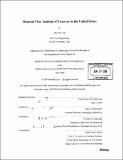| dc.contributor.advisor | John A. Ochsendorf and Timothy G. Gutowski. | en_US |
| dc.contributor.author | Low, Man-Shi | en_US |
| dc.contributor.other | Massachusetts Institute of Technology. Dept. of Architecture. | en_US |
| dc.coverage.spatial | n-us--- | en_US |
| dc.date.accessioned | 2006-06-19T17:34:02Z | |
| dc.date.available | 2006-06-19T17:34:02Z | |
| dc.date.copyright | 2005 | en_US |
| dc.date.issued | 2005 | en_US |
| dc.identifier.uri | http://hdl.handle.net/1721.1/33030 | |
| dc.description | Thesis (S.M.)--Massachusetts Institute of Technology, Dept. of Architecture, 2005. | en_US |
| dc.description | MIT Rotch Library copy is in leaves. | en_US |
| dc.description | Also issued in leaves. | en_US |
| dc.description | Includes bibliographical references (p. 155-164). | en_US |
| dc.description.abstract | Concrete is the second most consumed material in the world after water. Due to the sheer mass of concrete consumed annually and its associated resource and environmental impacts, improving the materials management of concrete consumption is a critical problem in the United States. It is increasingly evident that the society lacks knowledge of the collective material composition of the urban environment-of how we produce, consume and dispose of concrete. This thesis argues that the lack of informational linkages is driving the individual approaches of the construction industry, policy makers, environmental agencies and waste management industry, which results in the current segregated and government-subsidized material management. In order to identify opportunities for more effective materials management, this thesis performs the first comprehensive Material Flow Analysis for concrete in the United States for the year of 1996 to identify opportunities for more effective materials management. The dominant concrete products and the end-use categories in the United States are identified. The associated water, energy and fuel consumption and emissions produced are also incorporated. Five lifecycle stages are covered: (i) extraction of raw materials, (ii) cement manufacturing, (iii) production, (iv) use and (v) waste management of concrete. Two untapped material management opportunities are identified: minimizing water consumption during the extraction stage and the off-site production stage. | en_US |
| dc.description.abstract | (cont.) In addition, three key observations are made: (i) the energy efficiency of the cement industry in the United States is close to saturation, (ii) product choice and concrete design are dominant factors for a more responsible materials consumption approach, and (iii) demand-side management is recommended as a more optimal approach than recycling in dealing with the current construction trends in the United States. | en_US |
| dc.description.statementofresponsibility | by Man-Shi Low. | en_US |
| dc.format.extent | 189 p. | en_US |
| dc.format.extent | 10668276 bytes | |
| dc.format.extent | 10679762 bytes | |
| dc.format.mimetype | application/pdf | |
| dc.format.mimetype | application/pdf | |
| dc.language.iso | eng | en_US |
| dc.publisher | Massachusetts Institute of Technology | en_US |
| dc.rights | M.I.T. theses are protected by copyright. They may be viewed from this source for any purpose, but reproduction or distribution in any format is prohibited without written permission. See provided URL for inquiries about permission. | en_US |
| dc.rights.uri | http://dspace.mit.edu/handle/1721.1/7582 | |
| dc.subject | Architecture. | en_US |
| dc.title | Material flow analysis of concrete in the United States | en_US |
| dc.type | Thesis | en_US |
| dc.description.degree | S.M. | en_US |
| dc.contributor.department | Massachusetts Institute of Technology. Department of Architecture | |
| dc.identifier.oclc | 62096322 | en_US |
